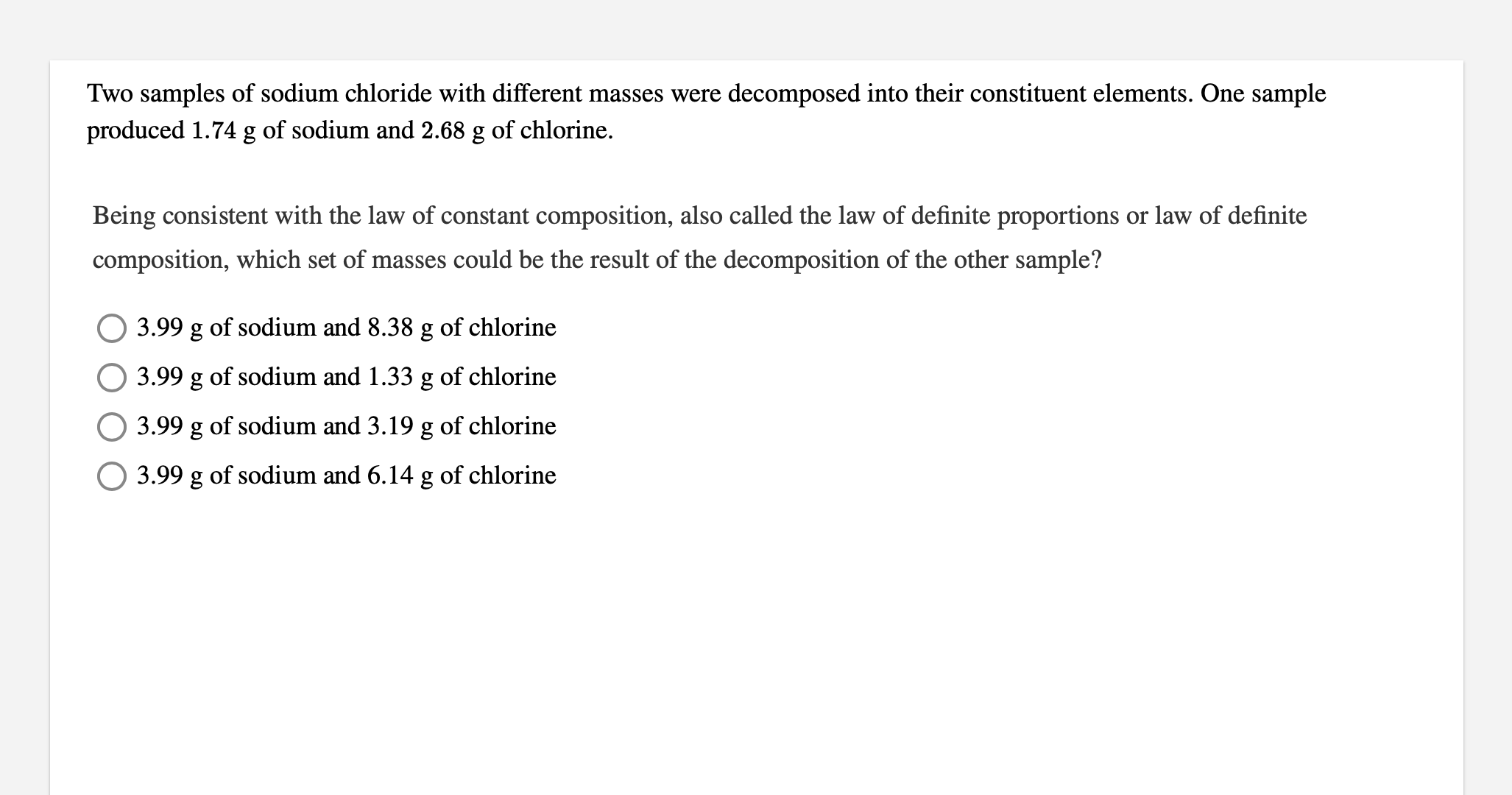Two samples of sodium chloride with different masses were decomposed into their constituent elements. One sample produced 1.74 g of sodium and 2.68 g of chlorine. Being consistent with the law of constant composition, also called the law of definite proportions or law of definite composition, which set of masses could be the result of the decomposition of the other sample? 3.99 g of sodium and 8.38 g of chlorine 3.99 g of sodium and 1.33 g of chlorine 3.99 g of sodium and 3.19 g of chlorine O 3.99 g of sodium and 6.14 g of chlorine
Two samples of sodium chloride with different masses were decomposed into their constituent elements. One sample produced 1.74 g of sodium and 2.68 g of chlorine. Being consistent with the law of constant composition, also called the law of definite proportions or law of definite composition, which set of masses could be the result of the decomposition of the other sample? 3.99 g of sodium and 8.38 g of chlorine 3.99 g of sodium and 1.33 g of chlorine 3.99 g of sodium and 3.19 g of chlorine O 3.99 g of sodium and 6.14 g of chlorine
General Chemistry - Standalone book (MindTap Course List)
11th Edition
ISBN:9781305580343
Author:Steven D. Gammon, Ebbing, Darrell Ebbing, Steven D., Darrell; Gammon, Darrell Ebbing; Steven D. Gammon, Darrell D.; Gammon, Ebbing; Steven D. Gammon; Darrell
Publisher:Steven D. Gammon, Ebbing, Darrell Ebbing, Steven D., Darrell; Gammon, Darrell Ebbing; Steven D. Gammon, Darrell D.; Gammon, Ebbing; Steven D. Gammon; Darrell
Chapter2: Atoms, Molescules, And Ions
Section: Chapter Questions
Problem 2.104QP: Two samples of different compounds of sulfur and oxygen have the following compositions. Show that...
Related questions
Question
i do know what else to do, that is the question

Transcribed Image Text:Two samples of sodium chloride with different masses were decomposed into their constituent elements. One sample
produced 1.74 g of sodium and 2.68 g of chlorine.
Being consistent with the law of constant composition, also called the law of definite proportions or law of definite
composition, which set of masses could be the result of the decomposition of the other sample?
3.99 g of sodium and 8.38 g of chlorine
3.99 g of sodium and 1.33 g of chlorine
3.99 g of sodium and 3.19 g of chlorine
O 3.99 g of sodium and 6.14 g of chlorine
Expert Solution
This question has been solved!
Explore an expertly crafted, step-by-step solution for a thorough understanding of key concepts.
This is a popular solution!
Trending now
This is a popular solution!
Step by step
Solved in 3 steps with 2 images

Knowledge Booster
Learn more about
Need a deep-dive on the concept behind this application? Look no further. Learn more about this topic, chemistry and related others by exploring similar questions and additional content below.Recommended textbooks for you

General Chemistry - Standalone book (MindTap Cour…
Chemistry
ISBN:
9781305580343
Author:
Steven D. Gammon, Ebbing, Darrell Ebbing, Steven D., Darrell; Gammon, Darrell Ebbing; Steven D. Gammon, Darrell D.; Gammon, Ebbing; Steven D. Gammon; Darrell
Publisher:
Cengage Learning


Chemistry: An Atoms First Approach
Chemistry
ISBN:
9781305079243
Author:
Steven S. Zumdahl, Susan A. Zumdahl
Publisher:
Cengage Learning

General Chemistry - Standalone book (MindTap Cour…
Chemistry
ISBN:
9781305580343
Author:
Steven D. Gammon, Ebbing, Darrell Ebbing, Steven D., Darrell; Gammon, Darrell Ebbing; Steven D. Gammon, Darrell D.; Gammon, Ebbing; Steven D. Gammon; Darrell
Publisher:
Cengage Learning


Chemistry: An Atoms First Approach
Chemistry
ISBN:
9781305079243
Author:
Steven S. Zumdahl, Susan A. Zumdahl
Publisher:
Cengage Learning

Chemistry & Chemical Reactivity
Chemistry
ISBN:
9781337399074
Author:
John C. Kotz, Paul M. Treichel, John Townsend, David Treichel
Publisher:
Cengage Learning

Chemistry & Chemical Reactivity
Chemistry
ISBN:
9781133949640
Author:
John C. Kotz, Paul M. Treichel, John Townsend, David Treichel
Publisher:
Cengage Learning

Introductory Chemistry: An Active Learning Approa…
Chemistry
ISBN:
9781305079250
Author:
Mark S. Cracolice, Ed Peters
Publisher:
Cengage Learning